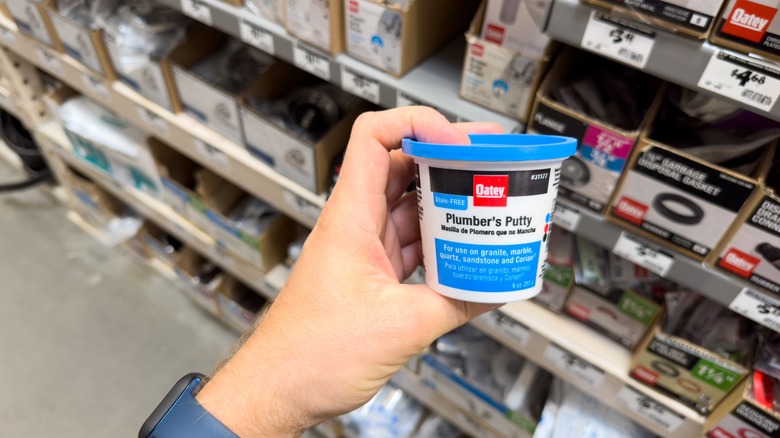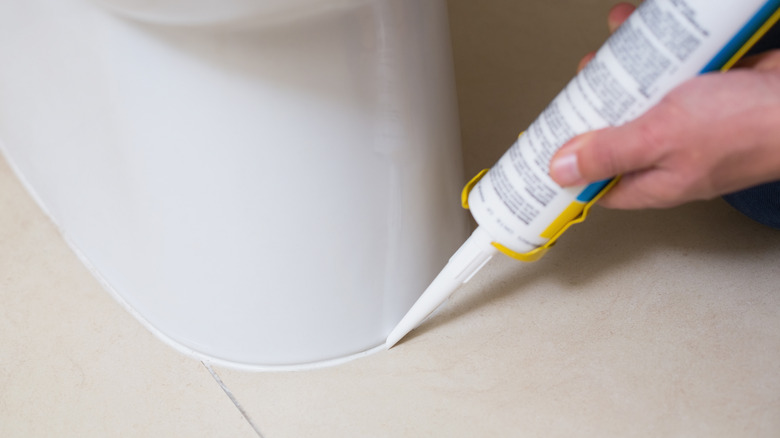Why Plumber's Putty Isn't Always The Best Fix For Toilet Repairs
If you've had to tackle DIY plumbing projects around the house, you know how indispensable plumber's putty can be. Thanks to this Play-Doh-like substance, you can easily set your faucets, and drains, then take them out without struggling when they're in need of a fix (good luck removing the fittings if you've sealed them with silicone!). Made with clay and oils (usually vegetable or mineral), plumber's putty is extremely pliable. Once applied, the putty creates an air- and watertight seal, and remains malleable for a long time — this quality makes it an excellent caulking agent for sealing fixtures that carry unpressurized water or replacing bathroom sink drains.
That said, plumber's putty's signature malleability is also an Achilles' heel for the product. Since it doesn't harden, plumber's putty can be easily disturbed, which is why it's not recommended for applications where the seal would experience weight or pressure. And while some plumbers do use the putty to seal toilet cracks or caulk your toilet, it's not an ideal application for the product. For one, the putty cannot withstand the weight of a toilet and its users. Likewise, it's not capable of forming a watertight seal, nor does it have the adhesive properties needed to secure the toilet to the floor. What's worse, if you use the putty to fix a crack in the toilet bowl or caulk the bottom of the bowl, you'll subject the already frail seal to chemical cleaners and urine, causing it to wear out faster. Below, we'll explain what product to use when creating watertight seals during toilet installation or repairs.
How to create a watertight seal when repairing a toilet
If your toilet has a crack, a two-part epoxy sealer is much better than plumber's putty, as it creates an effective watertight seal in the tiny gap. Two-part epoxy sealant consists of epoxy resin and a hardening compound. When these two substances are mixed, the ensuing chemical reaction allows the mixture to create powerful bonds. The substance is often used as an adhesive, but also makes for a fantastic gap-filling agent — exactly the kind you'd want when repairing an underwater toilet crack. Once the epoxy is applied and has enough time to cure, it hardens and adheres to the adjacent surfaces. To seal your toilet crack with epoxy, start by draining the toilet and drying the affected area thoroughly. Next, mix the epoxy resin and hardening compound per the manufacturer's instructions, and apply the sealant to the crack. Wipe any excess off, then refrain from using the toilet until the sealant has dried; epoxy usually needs 24 hours to cure.
Now, if you're installing a new toilet, caulking the base is a good idea. Not only does caulking your toilet prevent leaks, it also makes the toilet more stable by bonding it to the floor. Silicone caulk is the best compound to use to seal the base to the floor. Unlike plumber's putty, it's both malleable and water-resistant. Start by cleaning the interface between the toilet and the floor. Then, apply painter's tape adjacent to the joint to keep the silicone from getting on other surfaces. Now, place the caulk cartridge into the gun, and carefully apply the compound to the gap around the base. Then remove the tape, and use a moistened cloth to smooth the silicone bead. Finally, let the caulk cure for 24 hours before using the toilet.

